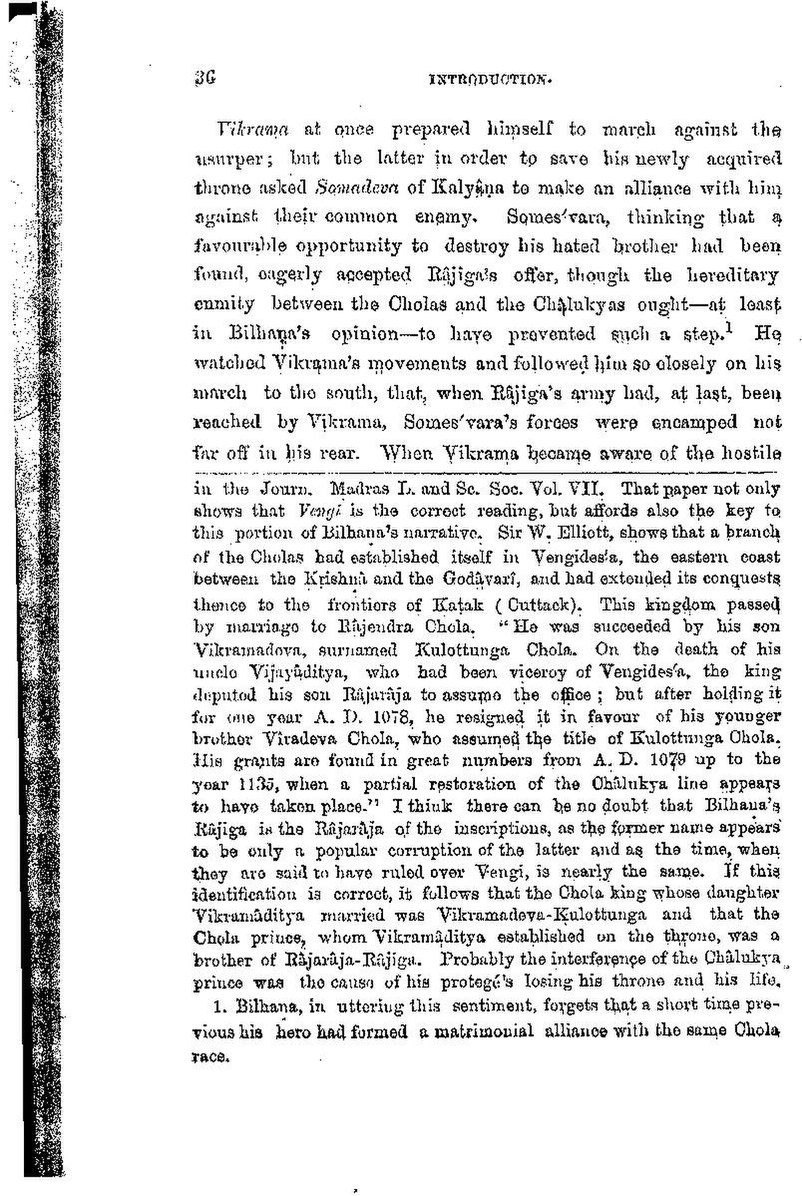3G
INTRODUCTION.
Tikrama at once prepared himself to march against the
usurper; but the latter in order to save his newly acquired
throne asked Samadeva of Kalyana to make an alliance with him
against their common enemy. Somes vara, thinking that a
favourable opportunity to destroy his hated brother had been
found, oagerly accepted Rajiga's offer, though the hereditary
enmity between the Cholas and the Chalukyas ought-at least
in Bilhapa's opinion-to have provented such a step.¹ He
watched Vikrama's movements and followed him so closely on his
march to the south, that, when Rajiga's army had, at last, been
reached by Vikrama, Somes'vara's forces were encamped not
far off in his rear. When Vikrama became aware of the hostile
in the Journ. Madras I. and Sc. Soc. Vol. VII. That paper not only
shows that Vengi is the correct reading, but affords also the key to
this portion of Bilhana's narrative. Sir W. Elliott, shows that a branch
of the Cholas had established itself in Vengides'a, the eastern coast
between the Krishni and the Godavarî, and had extended its conquests
thence to the frontiors of Katak (Cuttack). This kingdom passed
by marriago to Rajendra Chola. "He was succeeded by his son
Vikramadova, surnamed Kulottunga Chola. On the death of his
unclo Vijayaditya, who had been viceroy of Vengidesa, the king
deputod his son Rajaraja to assume the office; but after holding it
for one year A. I. 1078, he resigned it in favour of his younger
brother Viradeva Chola, who assumed the title of Kulottunga Ohola.
His grants are found in great numbers from A. D. 1079 up to the
year 1135, when a partial restoration of the Ohalukya line appears
to have taken place." I think there can be no doubt that Bilhaua's
Rajiga is the Rajaraja of the inscriptions, as the former name appears
to be only a popular corruption of the latter and as the time, when
they are said to have ruled over Vengi, is nearly the same. If this
identification is correct, it fullows that the Chola king whose daughter
Vikramaditya married was Vikramadeva-Kulottunga and that the
Chola priuce, whom Vikramaditya established on the throne, was a
brother of Rajaraja-Rajiga. Probably the interference of the Châlukya
prince was the cause of his protegé's losing his throne and his life.
1. Bilhana, in uttering this sentiment, forgets that a short time pre-
vious his hero had formed a matrimonial alliance with the same Chola
race.
पृष्ठम्:विक्रमाङ्कदेवचरितम् - बिल्हण.pdf/४०
एतत् पृष्ठम् अपरिष्कृतम् अस्ति

